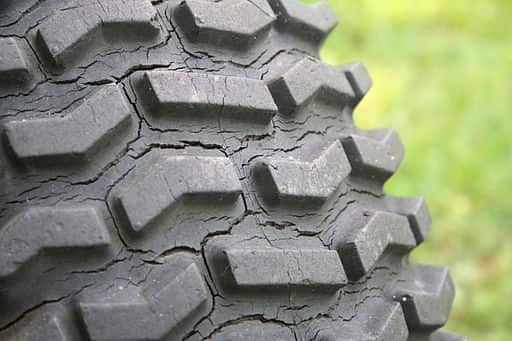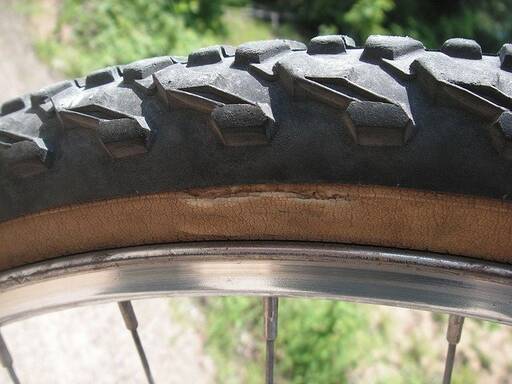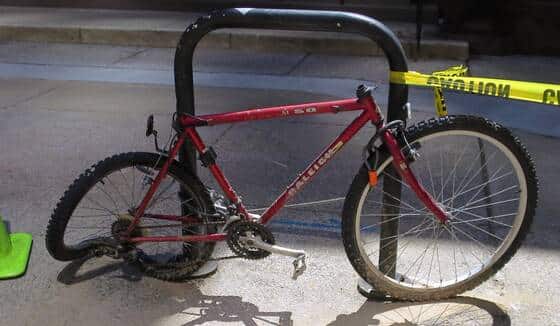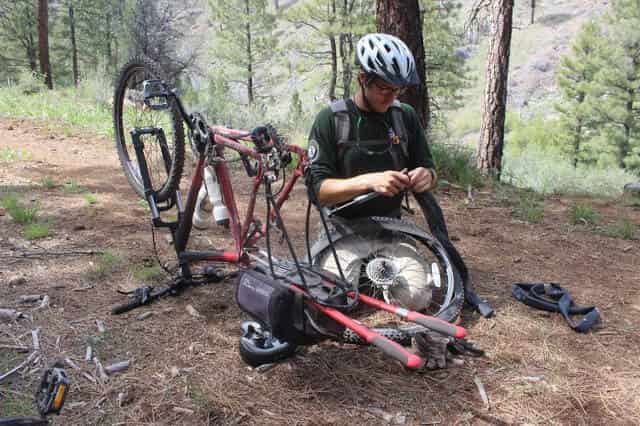Are you puzzled about the life expectancy of bike tires and when to replace them?
You’re not alone! As a cyclist, it can be difficult understanding what kind of wear and tear your tires will experience – especially if you’re just starting out.
Knowing how often to buy new bike tires is important for optimizing your performance and keeping yourself safe on the roads or trails.
Even when not in use, bike tires can quickly wear out if exposed to the elements. Sunlight and heat may cause them to rot or crack while moisture can lead to deterioration over time.
In this blog post, we’ll discuss all that you need to know about how long bicycle tires should last as well as cost-effective tips on how to prolong them.
Average Lifespan for Mountain Bike Tires | 3,000 to 8,000 miles |
Average Lifespan for Road Bike Tires | 1,000 to 3,000 miles |
Average Lifespan for Racing Bike Tires | 1,000 miles |
Average Lifespan of Bike Tire
The life expectancy of a bike tire is highly dependent on the kind of bike and tire you are using. Sturdier, thicker tires like mountain bike ones can last three to four times longer than thinner tires.
Another factor to consider is the environment in which you use your bike- roads with a smaller gauge or even gravel roads can be quite difficult on delicate tires, while smooth pavement will give them more longevity.
Generally, bike tires provide anywhere from 1,000 to 3,000 miles of riding mileage depending on the type of tire. Road tires provide an acceptable range from 1,000 to 3,000 miles while specializing in flat terrain.
If you’re wanting more distance and performance out of your tire, rupture-resistant and touring supports will last upwards of 3,000 miles before considering a replacement.
With racing tires, that number drastically decreases as they rely heavily on design-oriented features rather than durability–tending to only reach 1,000 or slightly higher compared to other types of tire.
Despite being less durable than commuters or trail riders, high-end road tires should still increase the longevity with a peak performance ranging from 2,500 to even 4,000 miles if taken care of properly.
When comparing tire types between a long distance hike off the beaten path; however there are none better than a reliable trail tire lasting up an impressive 8,000 in total mileage with no signs of slowing down.
Finally, how often you use your bicycle generally affects how long the tires last; occasional leisure cyclists can get away with replacing their tires less frequently than frequent cyclists.
All in all, taking protecting measures for your type of tire will ensure it stands the test of time.
7 Warning Signs To Look For When It Comes To Replacing
Having a good set of tires can save you some money and time as they tend to last for anywhere from one year or two years, or even more if you’re lucky.
That is unless you’re riding more than twenty miles a day, in which case your tires will likely have to be replaced fairly regularly. However if your daily commute is shorter than this then it could be possible to get up to three or four years out of your tires, extending their longevity even further.
With this in mind though, there are certain warning signs that indicate when it may be time to replace them.
Tire Wear / Tread Erosion
The tread on your bicycle tires is one of the most functional components. You can still ride without them but that would not be safe specially in dirt, wet surface and sand.
Without their knobby protrusions, all-terrain and mountain bike tires would lack the necessary traction for accelerating and changing directions when riding in loose dirt or sand.
The shallow grooves on standard road bike tires are designed to move water out of the way in order to ensure a safe ride in wet conditions.
If you’re unsure if your tires have worn down too far, a simple visual inspection should be enough to confirm whether they must be replaced. When the knobs and grooves become nearly level with the remaining rubber, it is definitely time to invest in new tires.

Cracked Rubber
Keeping your bike tires in great shape is necessary for a safe and enjoyable ride. Unfortunately, even when you don’t use your bike, the tires will still deteriorate slowly over time.
This deterioration can usually be seen in the form of cracks on the rubber surface. These cracks can vary from thin lines that are only visible upon close inspection to deep gaps easily seen by the naked eye.
The amount of direct sunlight exposure plays a detrimental role in this process, as it accelerates tire breakdown; typically starting from the sidewalls which are stretched most from pressure.
If you come across long, deep or numerous cracks on your tire, be sure to replace them immediately, as they could burst at any given time while you’re cycling.
Nicks, Cuts And Holes
The only bike tires you’ll find in perfect condition are those that have never been ridden upon. The moment they touch the road, they begin to collect signs of damage.
Design features are meant to address this, from toughness to thickness, and even chemical coatings. But, there is no way to prevent this damage completely
Take a look at your tires and you’ll find plenty of evidence this is so. Yet, because most of these marks are superficial, they don’t impact the safety or performance of your tire.
Gradually, however, the sheer number of nicks can impact the integrity of the material.
Small cuts, once formed, will begin to lengthen and deepen. They can collect small rocks and grit that can become impacted and cause punctures or other damage.
Look for marks that cut deep, or holes that are collecting debris, are hard to clear and don’t close up when cleaned. If you find any of this, it’s time to change the tire.

Visible Subtread or Casing
Tires are constructed in layers. The outermost layer is the tread, the only part of the bike intended to contact the road. This is the thickest and strongest part of the tire, as it has to stand up to all punishment.
If you can make out the carcass thread, or diagonal pattern beneath the rubber known as the protection belt, this could mean that your tire’s life expectancy is coming to an end.
Even if your tire has not been used for that long and has not clocked many miles, you should still keep an eye out for threads or cracks on the sidewall.
Known as the flank, this part of the tire is thinner and more prone to damage if left neglected.
It doesn’t necessarily signify immediate failure but replacing it sooner rather than later is hugely beneficial and will give you peace of mind on road trips. Taking preventative steps in terms of tire maintenance could save you from an inconvenient and critical predicament later down the line.
“Squaring Off”
All bike tires start out as perfectly round circles, but over time and use those circles will naturally start to flatten out.
This phenomenon is known as “squaring off” and it can have serious consequences for your riding experience if left unchecked.
Squared-off tires lead to faster tread wear and its accompanying safety risks, so it’s important to replace them as soon as you notice that the shape of your tires has changed.
If you’re already noticing a difference in handling due to squared-off tires, chances are that there’s very little tread left at all. Protect yourself by replacing worn-out tires with fresh ones right away!
Recurring Flats
It makes sense to patch a tire instead of replacing it when you experience a single flat, especially if you know exactly what the cause was. But, what about when your bike tire keeps going flat, and you can’t figure out why? At that point, it can be best to replace it.
The problem is that there are many ways that damage to the tire can manifest, and it’s not always easy to find or fix. Moreover, a flat means more than just damage to the tire. The inner tube is taking damage.
The tire could have a poor fit to the rim, allowing the tube to be pinched.
A fine, nearly invisible bit of wire may be lodged in the inner casing so that even a new tube will be punctured the moment you ride on the tire in question. Regardless, if a tire is going flat and you can’t figure out why, it’s safer to replace it than to take a chance riding on it.

Deformation
To function ideally, bike tires need to maintain their streamlined shape. As we’ve seen, wear from normal use will gradually reshape them, but more extreme conditions can cause dramatic deformation that instantly and obviously make them unsafe and unusable.
Internally, tires have as many points of failure as they have layers, as these layers are held together with glue. Hard impacts can cause the layers to detach, leading to bulges and warping of the outer tread.
This can even detach the casing from the metal wires that hold the tire’s shape, called the beads, so that won’t properly seat into the rim.
The outside of the tire can also deform. Exceptionally hot asphalt can cause the tire to melt, allowing it to become misshapen.
Hard stops at high speeds will chew right through the rubber in a skid, leaving a noticeable flat spot. If there is anything that seriously alters the shape of the tire, plays it safe, and remove it.
Common Reasons Bike Tires Go Bad
1. Exposure to Excessive Heat and Sun Light
Bike tires are an essential part of a cyclist’s journey, so it’s important to make sure that they get the care and maintenance they need.
Heat and sun exposure can be very damaging for bike tires, as it causes the rubber in the tires to dry out, becoming brittle and weak.
This type of degeneration intensifies over time, becoming cracked, brittle, or even developing dry rot.
Sunlight also has damaging UV rays that can cause rapid aging of your tires over time. To keep your bike tires in the best condition possible, store them in a shaded area whenever possible with proper ventilation.
Never expose your tires to sudden temperature changes like from an air conditioned room / store to sunny summer day.
2. Exposure to Weather or Excessive Moisture
The long-term effects of excessive moisture buildup on bike tires can be especially damaging over time. Exposed to too much water or humidity, the tire can start to rot and degrade.
This is because airtight seals break down and the rubber starts to degrade—leading to flat tires, weaker pressure abilities, loss of grip and other issues.
How often your bike tires are subjected to extreme moisture conditions should always be a factor when assessing the general condition of your bicycle tire maintenance routine.
Pay special attention to the climate in which you ride and make sure that your bike tires aren’t taking on more damage than they should!
3. Rough Use of Bicycle
Rough use of a bicycle is a common reason for bike tires to go bad. Tricks, wheelies, skidding and screeches can all wear down the tires over time which can significantly reduce its total life.
Braking and turning in particular can have an effect on tread consumption, so developing a smoother riding style will help ensure tires last for longer.
While it might be exciting to practice tricks and perform fast turns, conserving your tires is an important part of bicycle maintenance.
4. Lack of Ventilation
The same principle essentially applies to bike tires. Airflow is ultimately essential for wicking away excess heat and moisture, both of which can become detrimental if builds up on your tires over time.
It’s the same reason why you need breathable athletic clothing—it eliminates unnecessary sources of heat and moisture that could be unfavourably impacting your ride performance.
If you lack ventilation when storing your bike tires, it can cause the rubber to break down more quickly due to increased exposure to heat and light.
This can ultimately reduce their overall performance significantly.
5. Running Low on Air Pressure
When it comes to the wear and tear of bike tires, air pressure plays a major role. High pressure is often used for road bikes as it can improve speed and rolling performance.
However it can also make them more prone to blowouts when hitting potholes.
On the other hand, if you run your tires at low pressure for prolonged periods of time, they will experience increased wear and are more likely to get pinch-type flats and loss of control while riding.
To get the best tire performance possible, ensure that your bike tires are inflated at their recommended air pressure level.

Factors That Impact The Life of Your Bicycle Tire
Bicycle tires have a limited lifespan and several factors can impact how long they last.
Temperature, terrain, weight of the rider, tire pressure and regular maintenance all play an important role in the life of your bicycle tire.
Temperature is a major factor that affects the lifespan of your bicycle tire as extreme temperatures can cause rubber to harden and crack. In colder climates, it is important to store your tire indoors or in a garage to avoid any significant damage from the cold temperatures.
The terrain you ride on also affects the longevity of your bicycle tire. Riding on rough trails with sharp edges can cause more wear and tear than riding on smooth roads, resulting in more frequent tire replacements.
Weight of the rider also plays a role in how long your bicycle tire lasts. Heavier riders put more strain on their tires, leading to faster wear and tear.
Maintaining the right tire pressure is also essential for extending the life of your bicycle tires. Too much air can cause increased wear while too little air can make the tire vulnerable against punctures.
Lastly, regular maintenance of your bicycle tires is crucial for getting the most out of them. Keeping an eye on the wear and tear of your tires and replacing them before they are worn out can help to maximize their lifespan.

How To Make Your Bike Tires Last Longer
If you want your tires to carry you for thousands of miles, you have to combat all of the threats listed above. Luckily, it’s fairly simple to safeguard them, once you know what you’re protecting them from.
- Choose The Right Tires For The Terrain. Don’t take narrow, smooth tires into off-road conditions. Don’t ruin deeply threaded, soft mountain bike tires on asphalt. Tires will do their best when used as intended.
- Adjust Inflation To Reflect Your Style. While you can get by simply inflating both tires to the same manufacturer recommended psi, your tires will experience less wear if they are fine tuned to your weight distribution and usage.
- Don’t Let Them Sit For Long. If your bike is sitting unused, take it out for a short ride once every couple weeks. You don’t have to do anything strenuous. The point is simply to keep the tires flexible and protected.
- Carry Less Weight. To the degree that it’s possible, limit the amount of weight the tires have to bear. Always observe the max weight capacity. If you have to exceed it for some reason, make it brief, and don’t go more than 20 lbs over.
- Apply Tire Protectant. If you want to slow down the effects of weather, temperature, UV rays and ozone, you can apply a protectant. This will keep your tires in like new condition, longer.

Should I Replace Both Front and Rear Tires at the Same Time?
When it comes to replacing your bike tires, there is no one-size-fits-all solution. Whether or not you should replace both front and rear tires at the same time depends on a variety of factors.
If one set is more worn than the other, or has a different brand or type of treads, it might be worth considering buying two sets at the same time.
Doing this ensures that you’ll have equal traction and wear between the tires, and will make for a smoother riding experience overall.
However, if you decide to only replace one set of tires initially, be sure to check in regularly with a tire specialist who can advise when the other set needs attention.
Taking care of your bike tires is an important part of keeping it running as efficiently as possible – so whether you choose to do it all at once or over time, taking care of them should always stay top priority.
Conclusion
It’s easy to take tires for granted. Many riders only spare a thought for them when the road is visibly rough, or they hit a bump too hard. Take a moment to think of how many times that has happened to you, and it turned out your tires were just fine.
These hard-working rings, made of rubber, cloth, metal, and glue, are incredibly resilient. Ask yourself: what other parts on your bike last longer the more you use it? Your tires will carry you for hundreds of miles when you don’t take care of them. Just imagine how far they’ll go when you do.
Also Read,
How To Use A Bike Pump To Pump Your Bike Tire
Bike Tire Keeps Going Flat With No Puncture? Learn How To Fix It!









Leave a Reply